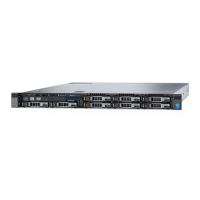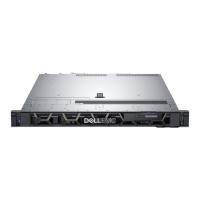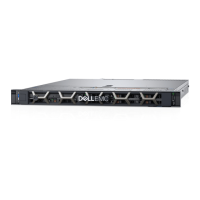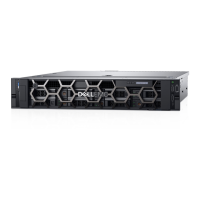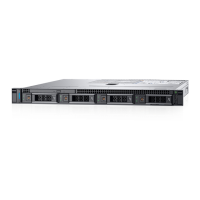9 Close the system.
10 Enter the System Setup and check the system memory setting.
If the problem is not resolved, proceed with the next step.
11 Open the system.
12 If a diagnostic test or error message indicates a specic memory module as faulty, swap or replace the module with a known good
memory module.
13 To troubleshoot an unspecied faulty memory module, replace the memory module in the rst DIMM socket with a module of the
same type and capacity.
If an error message is displayed on the screen, this may indicate a problem with the installed DIMM type(s), incorrect DIMM
installation, or defective DIMM(s). Follow the on-screen instructions to resolve the problem. For more information, see General
Memory Module Installation Guidelines.
14 Close the system.
15 As the system boots, observe any error message that is displayed and the diagnostic indicators on the front of the system.
16 If the memory problem is still indicated, repeat step 12 through step 15 for each memory module installed.
If the problem persists after all memory modules have been checked, see Getting help.
Troubleshooting an internal USB key
CAUTION: Many repairs may only be done by a certied service technician. You should only perform troubleshooting and simple
repairs as authorized in your product documentation, or as directed by the online or telephone service and support team.
Damage due to servicing that is not authorized by Dell is not covered by your warranty. Read and follow the safety instructions
that are shipped with your product.
1 Enter the System Setup and ensure that the USB key port is enabled on the Integrated Devices screen.
2 Turn o the system and attached peripherals, and disconnect the system from the electrical outlet.
3 Remove the system cover.
4 Locate the USB key and reseat it.
5 Install the system cover.
6 Turn on the system and attached peripherals and check if the USB key is functioning.
7 If the problem is not resolved, repeat step 2 and step 3.
8 Insert a dierent USB key that you know works properly.
9 Install the system cover.
If the problem is not resolved, see Getting help.
Troubleshooting an SD card
CAUTION
: Many repairs may only be done by a certied service technician. You should only perform troubleshooting and simple
repairs as authorized in your product documentation, or as directed by the online or telephone service and support team.
Damage due to servicing that is not authorized by Dell is not covered by your warranty. Read and follow the safety instructions
that are shipped with your product.
NOTE: Certain SD cards have a physical write-protect switch on the card. If the write-protect switch is turned on then the SD
card is not writeable.
1 Enter the System Setup and ensure that the Internal SD Card Port is enabled.
2 Turn o the system, including any attached peripherals, and disconnect the system from the electrical outlet.
3 Open the system.
CAUTION
: If the Internal SD Card Redundancy option is set to Mirror Mode in the Integrated Devices screen of the System
Setup, you must follow the instructions in step 4 through step 7 to avoid loss of data.
Troubleshooting your system 101

